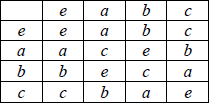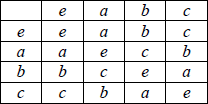Question
Given that p , q and r are elements of a group, prove the left-cancellation rule, i.e. \(pq = pr \Rightarrow q = r\) .
Your solution should indicate which group axiom is used at each stage of the proof.
Consider the group G , of order 4, which has distinct elements a , b and c and the identity element e .
(i) Giving a reason in each case, explain why ab cannot equal a or b .
(ii) Given that c is self inverse, determine the two possible Cayley tables for G .
(iii) Determine which one of the groups defined by your two Cayley tables is isomorphic to the group defined by the set {1, −1, i, −i} under multiplication of complex numbers. Your solution should include a correspondence between a, b, c, e and 1, −1, i, −i .
▶️Answer/Explanation
Markscheme
\(pq = pr\)
\({p^{ – 1}}(pq) = {p^{ – 1}}(pr)\) , every element has an inverse A1
\(({p^{ – 1}}p)q = ({p^{ – 1}}p)r\) , Associativity A1
Note: Brackets in lines 2 and 3 must be seen.
\(eq = er\), \({p^{ – 1}}p = e\), the identity A1
\(q = r\), \(ea = a\) for all elements a of the group A1
[4 marks]
(i) let ab = a so b = e be which is a contradiction R1
let ab = b so a = e which is a contradiction R1
therefore ab cannot equal either a or b AG
(ii) the two possible Cayley tables are
table 1
 A2
A2
table 2
 A2
A2
(iii) the group defined by table 1 is isomorphic to the given group R1
because
EITHER
both contain one self-inverse element (other than the identity) R1
OR
both contain an inverse pair R1
OR
both are cyclic R1
THEN
the correspondence is \(e \to 1\), \(c \to – 1\), \(a \to i\), \(b \to – i\)
(or vice versa for the last two) A2
Note: Award the final A2 only if the correct group table has been identified.
[10 marks]
Examiners report
Solutions to (a) were often poor with inadequate explanations often seen. It was not uncommon to see \(pq = pr\)
\({p^{ – 1}}pq = {p^{ – 1}}pr\)
\(q = r\)
without any mention of associativity. Many candidates understood what was required in (b)(i), but solutions to (b)(ii) were often poor with the tables containing elements such as ab and bc without simplification. In (b)(iii), candidates were expected to determine the isomorphism by noting that the group defined by {1, –1, i, –i} under multiplication is cyclic or that –1 is the only self-inverse element apart from the identity, without necessarily writing down the Cayley table in full which many candidates did. Many candidates just stated that there was a bijection between the two groups without giving any justification for this.
Solutions to (a) were often poor with inadequate explanations often seen. It was not uncommon to see \(pq = pr\)
\({p^{ – 1}}pq = {p^{ – 1}}pr\)
\(q = r\)
without any mention of associativity. Many candidates understood what was required in (b)(i), but solutions to (b)(ii) were often poor with the tables containing elements such as ab and bc without simplification. In (b)(iii), candidates were expected to determine the isomorphism by noting that the group defined by {1, –1, i, –i} under multiplication is cyclic or that –1 is the only self-inverse element apart from the identity, without necessarily writing down the Cayley table in full which many candidates did. Many candidates just stated that there was a bijection between the two groups without giving any justification for this.
Question
The set \(S\) is defined as the set of real numbers greater than 1.
The binary operation \( * \) is defined on \(S\) by \(x * y = (x – 1)(y – 1) + 1\) for all \(x,{\text{ }}y \in S\).
Let \(a \in S\).
a.Show that \(x * y \in S\) for all \(x,{\text{ }}y \in S\).[2]
b.i.Show that the operation \( * \) on the set \(S\) is commutative.[2]
b.ii.Show that the operation \( * \) on the set \(S\) is associative.[5]
c.Show that 2 is the identity element.[2]
d.Show that each element \(a \in S\) has an inverse.[3]
▶️Answer/Explanation
Markscheme
\(x,{\text{ }}y > 1 \Rightarrow (x – 1)(y – 1) > 0\) M1
\((x – 1)(y – 1) + 1 > 1\) A1
so \(x * y \in S\) for all \(x,{\text{ }}y \in S\) AG
[2 marks]
\(x * y = (x – 1)(y – 1) + 1 = (y – 1)(x – 1) + 1 = y * x\) M1A1
so \( * \) is commutative AG
[2 marks]
\(x * (y * z) = x * \left( {(y – 1)(z – 1) + 1} \right)\) M1
\( = (x – 1)\left( {(y – 1)(z – 1) + 1 – 1} \right) + 1\) (A1)
\( = (x – 1)(y – 1)(z – 1) + 1\) A1
\((x * y) * z = \left( {(x – 1)(y – 1) + 1} \right) * z\) M1
\( = \left( {(x – 1)(y – 1) + 1 – 1} \right)(z – 1) + 1\)
\( = (x – 1)(y – 1)(z – 1) + 1\) A1
so \( * \) is associative AG
[5 marks]
\(2 * x = (2 – 1)(x – 1) + 1 = x,{\text{ }}x * 2 = (x – 1)(2 – 1) + 1 = x\) M1
\(2 * x = x * 2 = 2{\text{ }}(2 \in S)\) R1
Note: Accept reference to commutativity instead of explicit expressions.
so 2 is the identity element AG
[2 marks]
\(a * {a^{ – 1}} = 2 \Rightarrow (a – 1)({a^{ – 1}} – 1) + 1 = 2\) M1
so \({a^{ – 1}} = 1 + \frac{1}{{a – 1}}\) A1
since \(a – 1 > 0 \Rightarrow {a^{ – 1}} > 1{\text{ }}({a^{ – 1}} * a = a * {a^{ – 1}})\) R1
Note: R1 dependent on M1.
so each element, \(a \in S\), has an inverse AG
[3 marks]
Examiners report
[N/A]
[N/A]
[N/A]
[N/A]
[N/A]
Question
The function \(f\,{\text{: }}\mathbb{Z} \to \mathbb{Z}\) is defined by \(f\left( n \right) = n + {\left( { – 1} \right)^n}\).
a.Prove that \(f \circ f\) is the identity function.[6]
b.i.Show that \(f\) is injective.[2]
b.ii.Show that \(f\) is surjective.[1]
▶️Answer/Explanation
Markscheme
METHOD 1
\(\left( {f \circ f} \right)\left( n \right) = n + {\left( { – 1} \right)^n} + {\left( { – 1} \right)^{n + {{\left( { – 1} \right)}^n}}}\) M1A1
\( = n + {\left( { – 1} \right)^n} + {\left( { – 1} \right)^n} \times {\left( { – 1} \right)^{{{\left( { – 1} \right)}^n}}}\) (A1)
considering \({\left( { – 1} \right)^n}\) for even and odd \(n\) M1
if \(n\) is odd, \({\left( { – 1} \right)^n} = – 1\) and if \(n\) is even, \({\left( { – 1} \right)^n} = 1\) and so \({\left( { – 1} \right)^{ \pm 1}} = – 1\) A1
\( = n + {\left( { – 1} \right)^n} – {\left( { – 1} \right)^n}\) A1
= \(n\) and so \(f \circ f\) is the identity function AG
METHOD 2
\(\left( {f \circ f} \right)\left( n \right) = n + {\left( { – 1} \right)^n} + {\left( { – 1} \right)^{n + {{\left( { – 1} \right)}^n}}}\) M1A1
\( = n + {\left( { – 1} \right)^n} + {\left( { – 1} \right)^n} \times {\left( { – 1} \right)^{{{\left( { – 1} \right)}^n}}}\) (A1)
\( = n + {\left( { – 1} \right)^n} \times \left( {1 + {{\left( { – 1} \right)}^{{{\left( { – 1} \right)}^n}}}} \right)\) M1
\({\left( { – 1} \right)^{ \pm 1}} = – 1\) R1
\(1 + {\left( { – 1} \right)^{{{\left( { – 1} \right)}^n}}} = 0\) A1
\(\left( {f \circ f} \right)\left( n \right) = n\) and so \(f \circ f\) is the identity function AG
METHOD 3
\(\left( {f \circ f} \right)\left( n \right) = f\left( {n + {{\left( { – 1} \right)}^n}} \right)\) M1
considering even and odd \(n\) M1
if \(n\) is even, \(f\left( n \right) = n + 1\) which is odd A1
so \(\left( {f \circ f} \right)\left( n \right) = f\left( {n + 1} \right) = \left( {n + 1} \right) – 1 = n\) A1
if \(n\) is odd, \(f\left( n \right) = n – 1\) which is even A1
so \(\left( {f \circ f} \right)\left( n \right) = f\left( {n – 1} \right) = \left( {n – 1} \right) + 1 = n\) A1
\(\left( {f \circ f} \right)\left( n \right) = n\) in both cases
hence \(f \circ f\) is the identity function AG
[6 marks]
suppose \(f\left( n \right) = f\left( m \right)\) M1
applying \(f\) to both sides \( \Rightarrow n = m\) R1
hence \(f\) is injective AG
[2 marks]
\(m = f\left( n \right)\) has solution \(n = f\left( m \right)\) R1
hence surjective AG
[1 mark]
